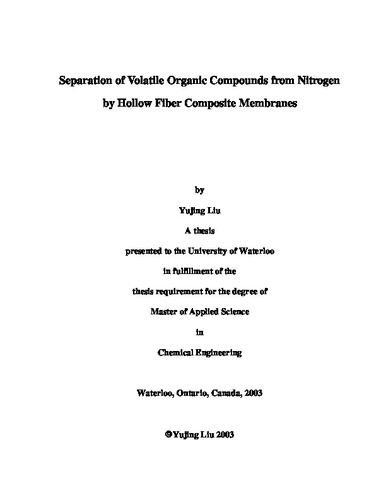| dc.description.abstract | Many industrial processes handling organic solvents produce volatile organic compounds (VOCs). These VOCs not only cause environmental pollution, but also represent an economic loss. VOC removal and recovery have become a big issue that needs to be addressed. Traditional techniques for VOCs removal include carbon adsorption, condensation, and absorption, and none is efficient enough to meet every need. Membrane separation has emerged as an excellent alternative or complementary technology for VOC separation. Separation of VOCs from nitrogen by composite hollow fiber membranes is studied in this thesis. Microporous hollow fiber membranes were spun from polyvinylidene fluoride (PVDF) using the phase inversion method, and the hollow fibers were coated with a thin layer of poly(ether block amide) (PEBA), thereby forming composite membranes. PVDF was chosen as the substrate material because of its excellent thermal and chemical stabilities and good mechanical strength, and PEBA was selected as the active separating layer because of its good permselectivity and film forming properties. In PEBA polymer, the hard polyamide blocks provide high mechanical strength, and the soft polyether blocks provide flexibility and elasticity. This study is focused on the preparation and characterization of PEBA/PVDF composite hollow fiber membranes. The membranes were tested for the removal of representative VOCs including hexane, heptane and cyclohexane, which are the main components of gasoline, and dimethyl carbonate (DMC), ethanol, methanol, and methyl t-butyl ether (MTBE) that are the oxygenates and octane number enhancers of gasoline. The separation of gasoline vapor from nitrogen was also investigated. It was found that the PEBA/PVDF composite hollow fiber membranes are effective for the separation of hydrocarbon vapors from nitrogen. The effects of hollow fiber membrane preparation conditions on the membrane performance were studied, and the separation performance of the composite hollow fiber membranes at various operating conditions (e. g. feed concentration, operating temperature) was evaluated. | en |

